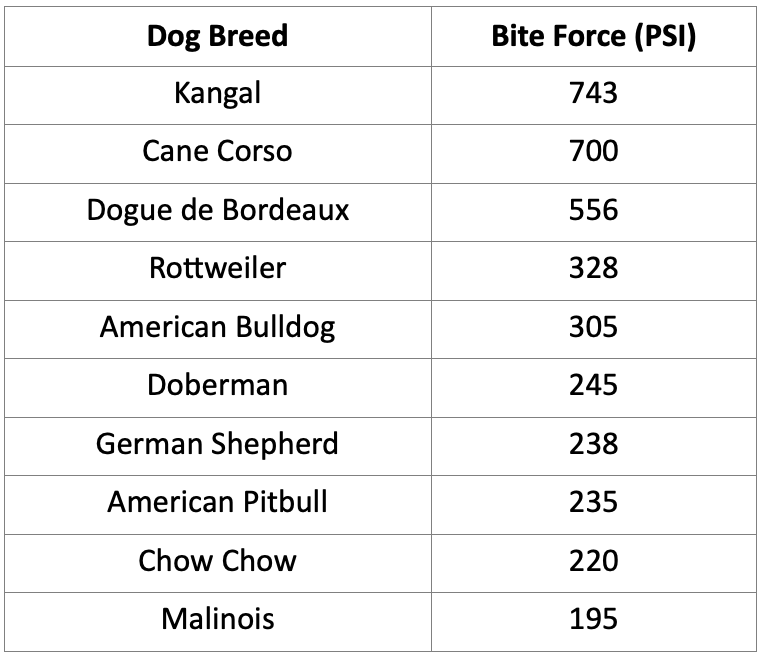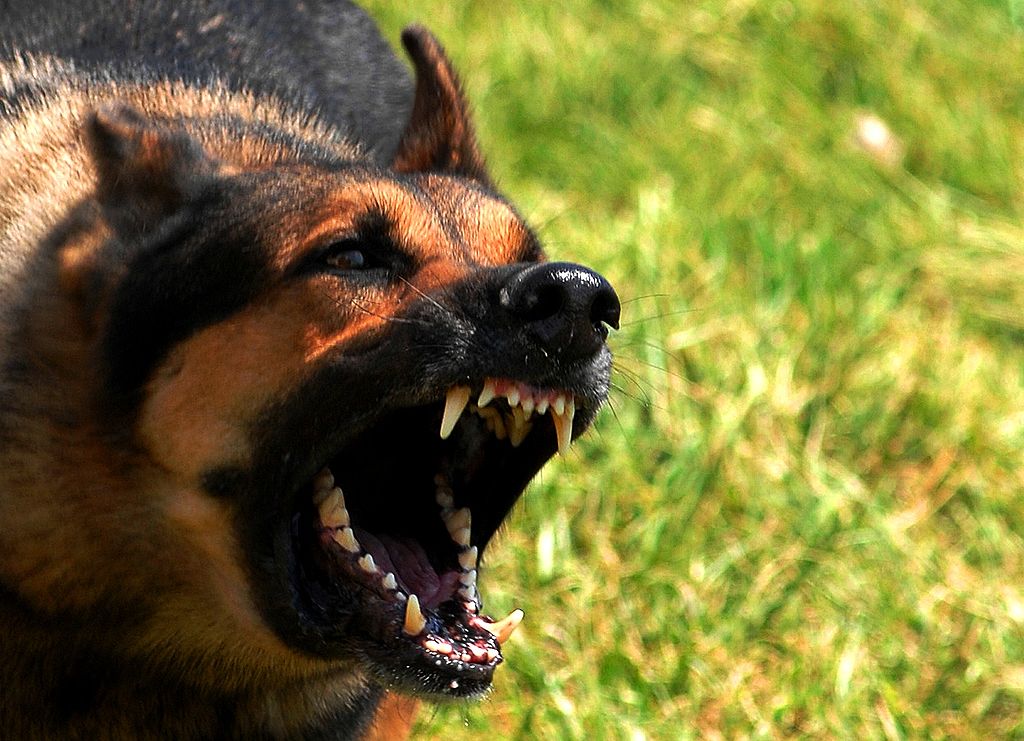For example, the bite force of a Nile crocodile is roughly 5,000 PSI. The bite force of the average human is much lower, at just 162 PSI.
Over generations, dogs have carved out in invaluable role in families across the world. When properly trained and taken care of, dogs can provide companionship, protection, and even fulfill life-saving tasks for their owners. However, if a dog is poorly trained, feral, or left unmonitored, it has the potential to cause serious injury to an inspecting victim.
In this article, we inspect dog attack statistics and facts from the past two decades. We wanted to explore why dogs attack, see who is most at risk of serious harm, and determine what can be done to defend oneself from an aggressive canine. To obtain recent and historical dog bite data for this study, we utilized the databanks of Dogs Love Us More and DogsBite.org.
How Powerful is a Dog’s Bite?
When someone mentions the dreaded words “dog bite,” you probably don’t immediately think of your friend’s basset hound or the neighbor’s talkative chihuahua as the aggressive canine in question. In most cases, a larger dog will have a much stronger bite force and thus the capability to cause greater harm. However, even if a dog breed has a very powerful bite, this does not make them any more prone to aggression than a smaller canine. A dog’s general temperament, training, and role within its family unit are much more indicative of its potential for violence.
To calculate a dog’s bite force, we use “Pounds per Square Inch,” or PSI. When PSI is calculated, it measures the entirety of pressure applied to a single square inch of one pound. When used in reference to a dog or another animal, PSI typically measures the force applied through a bite. For example, the bite force of a Nile crocodile is roughly 5,000 PSI. The bite force of the average human is much lower, at just 162 PSI. While neither dogs nor humans come anywhere close to the bite force of a crocodile, many breeds do have powerful jaws nonetheless.
In the table below, we display the ten dog breeds with the strongest bite forces.

What Factors Make a Dog More Likely to Attack?
In most cases, a dog bites after being provoked. Truly “random” attacks are rare and may indicate that a canine is sick. According to Academy Animal Hospital, some of the reasons a dog may bite someone include:
- As a reaction to stress, fear, or being startled
- To defend itself or its territory
- To protect something valuable, such as a toy, their food, or puppies
- As an accident during play, particularly during high-risk activities such as tug-of-war
If you observe that your dog appears anxious or uncertain in some situations, keep them on a secure lead and offer treats and reassurances to help counter their anxiety. Always be aware of your pet’s temperament and body language. If your dog snaps, growls, or attempts to bite in certain circumstances, document the cause and be sure to manage it carefully in the future.
Who is Most Likely to be Bitten by a Dog?
Established research carried out by Psychology Today indicates that children are significantly more likely to be the victims of dog attacks than adults. In fact, the publication states that children younger than fifteen suffer nearly three out of five bites. Of all children, those aged five to nine endure the most canine-related injuries, and most victims (67%) are young boys. A study performed in the Czech Republic indicates that an inability to correctly perceive canine body language contributes to the increased risk of harm for children.
During the study, children were asked to identify the emotions of different dogs. The six canine emotions used were joy, submission, attack, threat, fear, and friendliness. The participants identified the proper emotion only 17% of the time. Only one of three children were able to identify a fearful canine, while more than 90% of the study’s participants were unable to determine when a dog was showing attack or threat indicators. Without the ability to accurately recognize warning signs and escape a potentially dangerous situation, children are particularly vulnerable to “sudden” attacks.
Which Dog Breeds Cause the Most Nonfatal Bite Wounds?
To determine which breeds are historically responsible for the most injuries in the United States, we inspected data from September of 1982 through December 31st of 2014. This data has not been adjusted to prevent a bite incident from being listed twice if the responsible canine is a mixed breed.
For the context of this study, “molosser breeds” includes pitbulls, rottweilers, presa canarios, cane corsos, mastiffs, Dogo Argentinos, fila brasieros, sharpeis, boxers, and associated mixes. “Wolf-like breeds” consist of akitas, German shepherds, Karelian bear dogs, Malamutes, wolf hybrids, Shiba Inus, and associated mixes.
What Age Group Suffered the Most Fatal Bite Attacks in 2020?
In 2020, there were 46 fatal dog attacks in the U.S. Children aged 0-9 bore the brunt of these deadly bite incidents, with 15 victims falling into this age range. This aligns with what we understand about young children being especially vulnerable to dog attacks. Typically, young adults are not the victims of fatal dog attacks, but in 2020 there were three victims in both the 10-18 and 19-29 age ranges. The three victims in the 19-29 group were all male and attacked by pitbulls.
Exploring Fatal Dog Bite Attack Statistics From 2005-2020
Using data from 2005 to 2020 provided by Rodriguez & Associates, we broke down fatal dog attacks by breed over the sixteen-year timeframe. Over this period, pitbulls were responsible for 70.9% of lethal bite incidents. Rottweilers were involved in 9.5% of fatal dog attacks over the same timeframe. Of the 536 total victims, 251 were nine years old or younger. 149 of the victims were aged 0-2.
Taking an even closer look at the fatal attack statistics from 2005 to 2020, we see that more than half of the lethal bites occurred on-property and were inflicted by family dogs. 53.5% of deadly attacks were by a single dog, as opposed to an assault by multiple dogs or a full pack.
How to Identify a Potentially Dangerous Dog
Canines frequently display warning behavior before attacking. If you’re able to identify and react to the signs of a dangerous dog quickly enough, you may be able to avoid an attack altogether. Some common threat displays include:
- Aggressive and loud snarling, growling, or barking
- Biting at the air
- A tall, widened stance
- Bared fangs
- A slowly moving tail and stiff ears
If you become aware of any of these warning signs, try to remain calm and put space between you and the dog. Do not turn your back or run. If you are bitten, seek medical attention as soon as you can. If the dog has a form of infection, such as rabies, even a seemingly minor bite wound may cause serious harm.


Join the conversation!